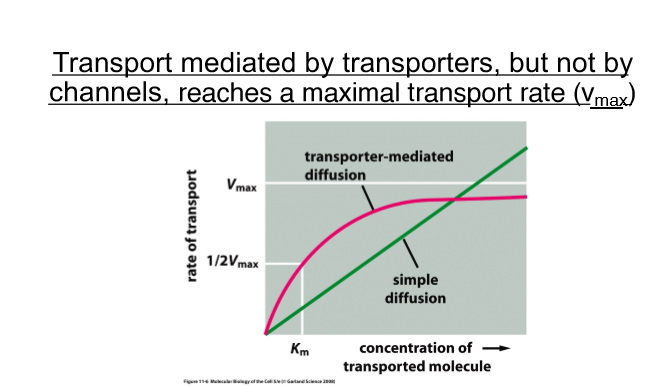D103 Membrane Proteins (ALS2, Videos 3 and 4)
1/42
There's no tags or description
Looks like no tags are added yet.
Name | Mastery | Learn | Test | Matching | Spaced |
|---|
No study sessions yet.
43 Terms
a lipid bilayer is permeable to
small hydrophobic molecules
small uncharged polar molecules
a lipid bilayer is impermeable to
large polar molecules
ions
purpose of transport proteins
make the lipid bilayer selectively permeable
3 different transport proteins
transporters (ex: GLUT1)
ATP-powered pumps (ex: Na+/K+ pump)
ion channels
common features of transport proteins
transmembrane proteins with multipleTMDs
protein-lined pathway across lipid bilayer, so that water-soluble molecules can pass without contacting hydrophobic core of membrane
conformational changes (most important!!)
protein conformations
determined by
AA sequence of the protein
interactions between individual amino acids (hydroen bonds, salt bridges, disulfide bonds, hydrophobic interactions)
conformational changes
are induced by
binding of a ligand
posttranslational mods of the protein
change in the pH, voltage, or temperature
hexokinase
ex of ligand-induced conformational change
glucose binding brings 2 domains closer together so that they are then surrounding glucose
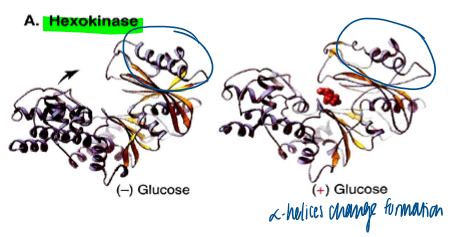
EF-Tu
ex of ligand-induced conformational changes
GTP binding induces EF-Tu (a cofactor in protein synthesis) to become more compact
GLUT1 deficiency syndrome (GDS)
genetic disorder that impairs brain metabolism
brain is not supplied with sufficient glucose
brings glucose from blood to nerve
symptoms: seizures, developmental delay, motor disorders
treatment: ketogenic (high fat) diet
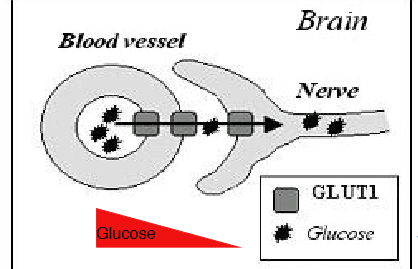
how does GLUT1 transport glucose
ex of uniporter
one or more specific binding sites for a solute (= substrate)
binding of solute induces a reversible conformational change in the transporter
direction of transport is inversed if the direction of the concentration gradient is changed (down conc gradient)

transporter-mediated transport and vmax
reaches a Vmax
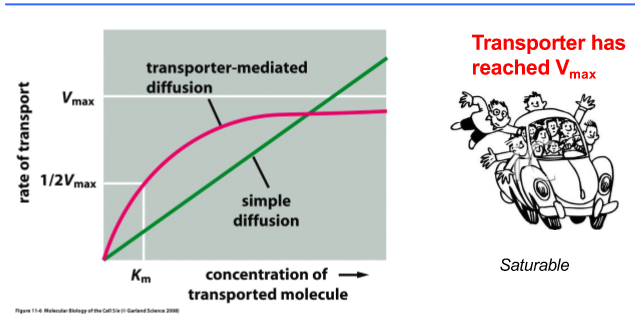
vmax
each is working at its maximal rate
all binding sites are filled (saturable transport)
Km
concentration at ½ Vmax
it is a measure of the transporter’s affinity for its solute
low Km = high affinity (inverse relationship)
how can we test experimentally how a mutation affects GLUT1 function
approach: isolate wt and mutant GLUT1 aend examine ability to transport glucose into a liposome
problem: GLUT1 is a transmembrane protein
extract protein from membrane with detergent molecules
reconstitute into liposomes
perform functional activity assays
passive transport
no ATP and down conc gradient
channel-mediated and transporter-mediated
active transport
transport against an electrochemical gradient with energy
energy input from
ATP driven pump; direct input of energy
electrochemicla gradient for one molecules drives the transport of the other; indirect input of energy
Na+/glucose symporter
2 Na+ goes with conc gradient, providing energy for the 1 glucose going against conc gradient
cooperative binding
binding stimulates conformational change of transporter
Na+ and glucose disassociate from transporter
disassociation allows symporter to revert to its original conformation
Na+/K+ pump
establish Na+ electrochemical gradient for glucose; both move against their gradients
3 Na+ out; 2 K+ in
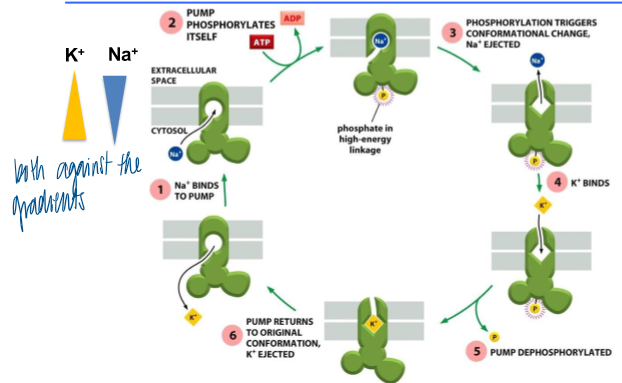
what membrane protein has the highest transport rate
ion channels (always passive)
types of gating in ion channels
voltage, ligand-gated extracellular, ligand-gated intracellular, mechanically gated
ligands are not transported; just for opening
selectivity of ion channels
selective for a specific ion (size and charge)
selectivity filter arranges molecules to pass in a single file
no actual ion binding site as seen in carriers
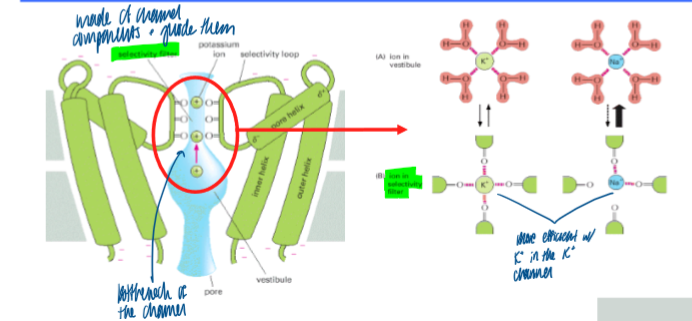
bacterial K+ channels
ion channel; homotetramer that experiences conformational change to allow the transport of K+ ions
dravet syndrome (myoclonic epilepsy of infancy)
initially has normal milestones, but has fever-induced (febrile) seizures in the first year
after that, seizures are triggered by slight changes in temp
developmental delays and features of austism
mutations in a Na+ channels involving gene SCN1A
mutations encoded by gene SCN1A
> 1250 mutations in the sodium channel Na v1.1 have been identified
26 TMDs in total
why are flies used as a model system to study epilepsy
Nav1.1 (in mammals): 9 isoforms that mediate Na+ transport
Para (in flies): the only voltage-gated sodium channel (1 vs 9 channels)
domains organization is conserved
regions in para that are critical for function are conserved
forward genetic screen
induce random mutations and study those that cause paralysis as well as temperature-induced seizures (novel mutation)
knock-in studies
express mutated human gene in drosphila → temp induced seizures
mutate and see how they repeat
what is an experimental model system
simple system to study a biological question
extrapolation of results to higher organisms
availability of genetics (good for larger organisms)
best to use the simplest possible system that allows a scientist to study a process
3 types of experimental model systems
prokaryotic cell (ex: e coli)
single cell eukaryotes (ex: yeast)
multicellular organisms (ex: mouse, fish, etc)
yeast model system
most simple (least number of genes)
haploid: esily generate mutants; good for genetics and screens
basic cell biological and genetics questions
fruit fly model system
diploid: genetics, screens for components
development from single cell to multicellular organism; cell biology
worm model system
diploid: genetics, screens for components
precise timing of development from single cell to adult with 959 cells; cell bio
mouse model system
most complex
diploid: gene deletion mutants and transgenic animals can be generated; genetics are possible
expensive
dvelopment, immunology, mammalian genetics and cell bio
which hydrophobicity plot most likely describes the protein with 3 TMDs
look at y axis
water → apolar = -△G for TMDs
look at x axis and range
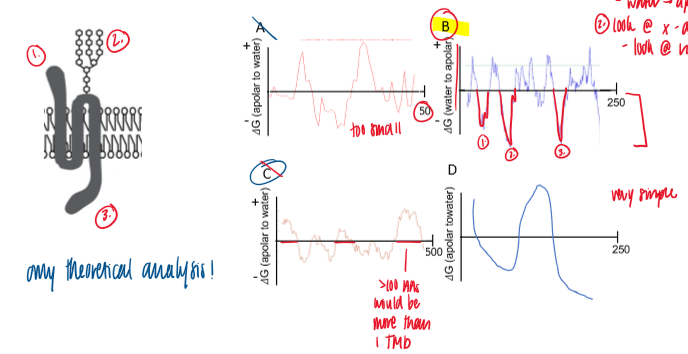
TMDs from apolar → water
hydrophobic domains (△G > 0)
TMDs from water → apolar
hydrophobic domains (△G < 0)
length of potential TMD
20 AAs = 3 nm
how many TMDs are in the protein
4
apolar → water = + G
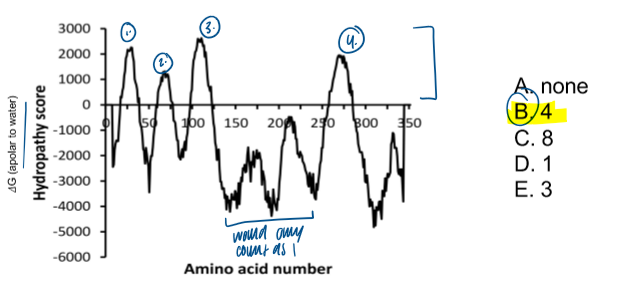
which of the following is most likely to induce conformational change in Na+ transporter that is necessary for Na+ transport
binding of Na+
in transporters, what is being transported causes the change; no separate ligand
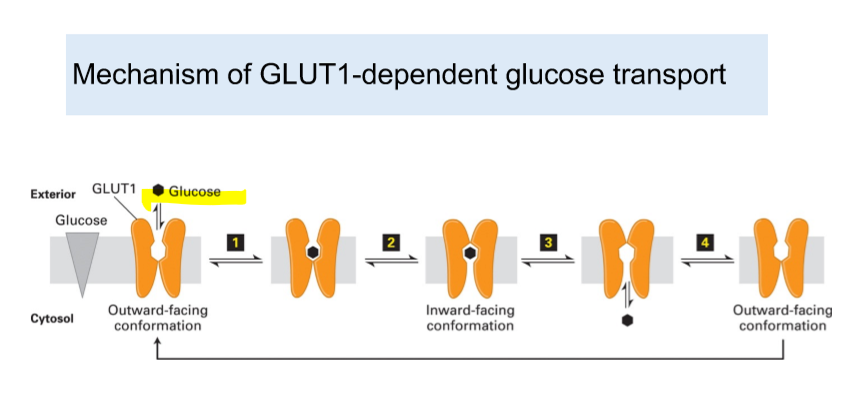
in glucose/ Na+ symporter, what is driving
na+ is the driving force in the apical membrane
epithelial cells contain 2 types of glucose transporter because
the glucose concentration in the intestine varies during the day (ex: before and after a meal)
need a symporter and uniporter for this reason
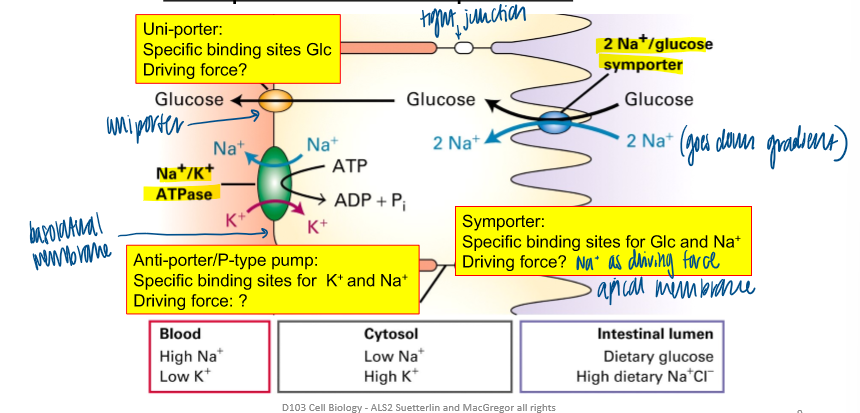
which of these graphs describes the transport of Ca2+ across a biological membrane
depends if a channel or if it is a transporter
